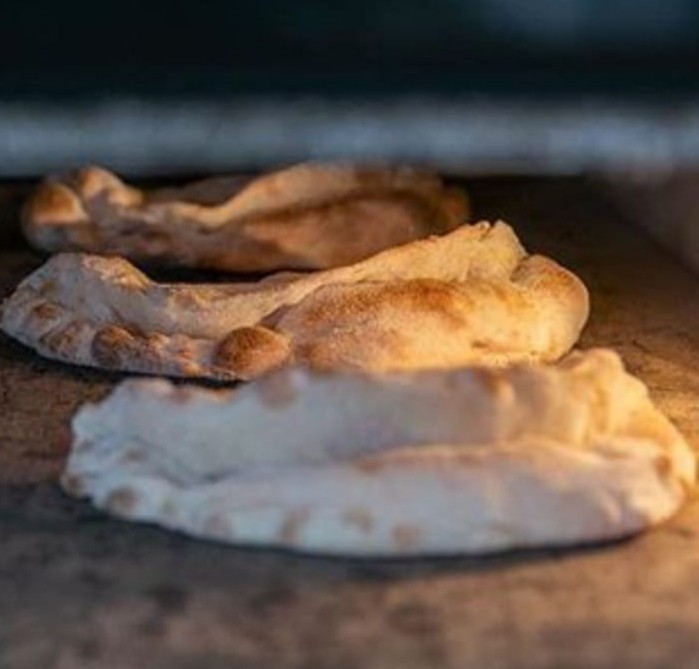Pinsa Romana: The Roman Pizza
Discover the Timeless Taste of Pinsa Romana
A unique product made with special mix of flours and a long maturation.
Where ancient Italian tradition meets modern culinary innovation. Pinsa Romana offers a uniquely satisfying experience — a light, airy crust with a delicate crunch, rich with flavor and history. Every bite brings you closer to the heart of Rome.
Crafted as a lighter, healthier alternative to classic Italian pizza, our hand-stretched, oval-shaped Pinsa is made with a carefully selected blend of flours and contains no additives, preservatives, or saturated fats. It’s vegan-friendly, low in gluten, and designed to be as easy on your body as it is delicious on your palate.
Thanks to a 72-hour dough fermentation process, our Pinsa is exceptionally digestible, lower in calories and fat, and leaves you feeling satisfied—not stuffed. With its irresistible taste and perfect texture, Pinsarella is a light and healthy pizza that doesn’t weigh you down or leave you with regrets.
Pinsarella — pizza reimagined for how you want to feel.
Roman Style Pizza: Origins and Evolution
The traditional Roman pizza has seen many reinterpretations over the centuries, evolving into the lighter, more refined version we know today.
The origins trace back to ancient Roman bakeries, where bakers would test oven temperatures by preparing a simple flatbread before beginning their daily bread production. That humble flatbread became the foundation for what we now know as Pinsa Romana and Roman pizza alla pala.
Thanks to modern innovations—like cold water dough preparation and the use of specialized flours—we’re now able to craft Pinsa Romana with a highly hydrated dough that’s both tastier and significantly lighter than the original recipes.
The name “Pinsa” comes from the Latin word pinsere, meaning to stretch and press. This reflects both the preparation method and the artisanal hand-stretched shape that defines the dish.
Over time, the recipe has evolved with the introduction of diverse grains and flours such as wheat, kamut, barley, spelt, and millet. Aromatic herbs were also added, giving pinsa a variety of flavor profiles throughout history. In its perfected modern form, Pinsa is made from a unique blend of wheat, soy, and rice flours. Compared to classic pizza dough, Pinsa uses more water and less yeast, resulting in a preparation that’s lighter, lower in calories, and easier to digest.
What Makes Roman Pinsa Unique?
- Oval shape – Artisanal and hand-stretched
- Delicate crispness – Crunchy on the outside, soft on the inside
- High digestibility – Thanks to long leavening and fermentation
- Special flour blend – Wheat, soy, rice, and sourdough
- Rich aroma and flavor – Developed through extended fermentation
While rooted in ancient tradition, modern Pinsa Romana is a breakthrough in pizza-making: lighter, healthier, and more enjoyable without compromise.
"Here at Pinsarella we think that to make the best food all the products must be produced locally with the use of high quality ingredients. Try our Pinsa Romana and Taste the Difference..."
The Secret to Roman Pinsa? It All Starts with the Flour.
As with all great recipes, Pinsa’s excellence begins with its foundation: the flour mix. Over the centuries, this traditional Roman dish has been reimagined many times — always with deep respect for its roots.
Our flour of choice is from Molino Iaquone, the first major Italian mill to specialize in creating a professional blend tailored specifically for authentic Pinsa Romana. This carefully crafted mix is what gives our Pinsa its unmistakable taste and texture.
A True Pinsa Romana Flour Blend Includes:
- Soft Wheat (Type 0): The classic Italian base
- Soy Flour: Enhances crispness and texture
- Rice Flour: Retains water for lightness and softness
- Dried Sourdough: Aids in natural fermentation and boosts digestibility
What Makes Pinsa Dough So Special?
Pinsa stands apart for its unique structure and digestibility. Its crisp, golden exterior gives way to a soft, airy interior — a texture only possible thanks to a specialized process that includes:
- A long, slow fermentation (minimum 48 hours)
- High hydration (80% water) for a lighter dough
- A special blend of flours and natural sourdough
- No animal fats and only a small amount of extra virgin olive oil
- A completely different mixing technique compared to traditional pizza
The use of rice flour is what creates that signature softness inside the crust.
Endless Possibilities: The Versatility of Pinsa
Preparing Pinsa is easy and endlessly customizable. Simply preheat your oven to 250°C (static mode) and top your crust with a drizzle of extra virgin olive oil, coarse sea salt, and fresh rosemary for a classic Roman flavor.
Want to get creative? The options are limitless:
- Add cherry tomatoes and buffalo mozzarella after baking
- Try a classic Margherita with tomato sauce and mozzarella
- Go savory with broccoli and sausage, tuna and onions, or beans and herbs
- Or even explore gluten-free variations for a lighter option
Pinsa is a blank canvas — whether simple or gourmet, it always delivers an unforgettable taste experience.









